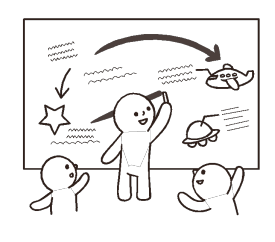Editing Discovery/alx
| Editing Discovery | |
| Contributors | Yuji Harashima, Tetsuro Kubota, Takashi Iba |
|---|---|
| Last modification | May 17, 2017 |
| Source | Harashima, Kubota & Iba (2014)[1] |
| Pattern formats | OPR Alexandrian |
| Usability | |
| Learning domain | |
| Stakeholders | |
You are discussing freely with learners in the project.
The meeting often ends without settlement of opinions, just with various opinions. If you don’t join the discussion and just hear learners’ discussion, the meeting will be often chaotic and will stop. On the other hand, if you lead the discussion, the meeting will proceed along your opinion. In the case, you can’t reflect learner’s opinion to the project. And, learners will be just there, they will not be able to learn by the discussion in their own initiative.
Track the opinions got in the discussion and edit the notes feely, then create new discoveries. Note the opinions got in the brainstorming or the discussion on a blackboard or a big paper. Then, write down anything learners said without sorting out and connect the opinions and think to produce discoveries to lead the project ahead. The blackboard or the paper that is noted the opinions should be where learners can see easily. You draw figures and pictures about the notes and what you think from the notes, and select them on the basis of whether it is useful for the project or not.
You can find new ideas, not only by learners’ firsthand opinions, but also by connecting opinions existed on the blackboard or papers and by drawing figures. You can use the opinions to find new discovery not only in the discussion but also after the discussion if you note that. Learners can say their opinions, which leads to the active discussion because they watch your attitude paying attention to many opinions.
References
- ↑ Harashima, Y., Kubota, T., & Iba, T. (2014). Creative education patterns: designing for learning by creating. In Proceedings of the 19th European Conference on Pattern Languages of Programs (EuroPLoP 2014) (p. 7). New York:ACM.
